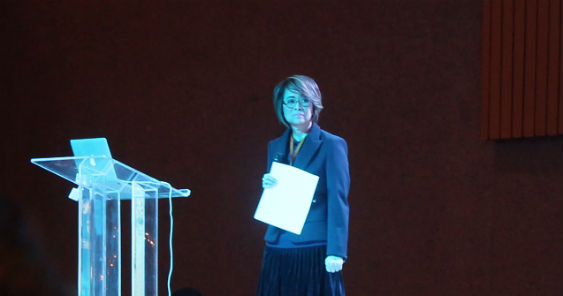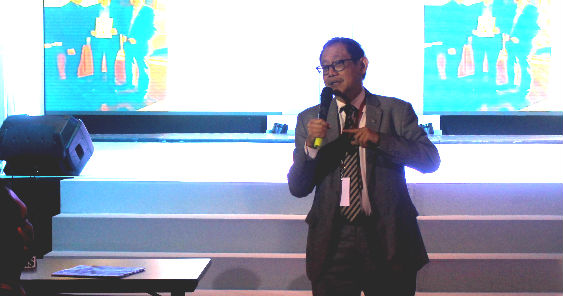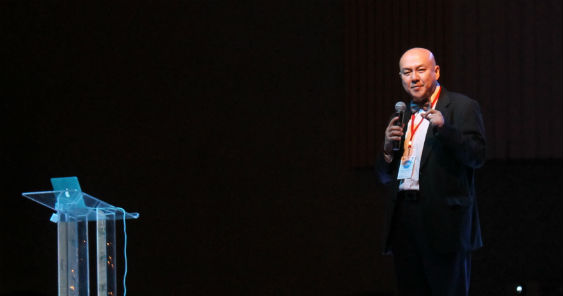MANILA – The first day of the Asian Marketing Congress kicked off on July 17 at the PICC Reception Hall.
Despite the previous day’s typhoon, marketing professionals were in high spirits as they attended the conference, which had marketing leaders from all over the region covering various topics.
Giving the opening remarks was Asian Marketing Federation president Takuya Goto, who commended the Philippines’ business landscape, saying “the Philippine economy is more stable and reliable for international investors.”
“I think the Philippines and the Philippine Marketing Association will be a model for the rest of the world in the future,” Goto said.
Following the opening remarks was the first speaker, PMA president Yayu Javier, whose talk, entitled “Competition vs. Synergy,” focused on the importance of cooperation in the ASEAN markets.
 “As leaders learn to collaborate despite differences in culture and ideologies, greater synergy will be born,” Javier said, explaining that ASEAN integration will open up opportunities to develop the ASEAN brand as a global brand.
“As leaders learn to collaborate despite differences in culture and ideologies, greater synergy will be born,” Javier said, explaining that ASEAN integration will open up opportunities to develop the ASEAN brand as a global brand.
Javier highlighted the areas that are open for synergy and collaboration within the ASEAN community, one of them being local manufacturing partnerships.
Using the example of the C2 green tea brand, Javier illustrated how the Universal Robina brand, through partnerships with others in the ASEAN region–including a team of people that includes both expats and locals–has gone on to penetrate 32 countries and territories around the world.
Retail is another area that is ripe for synergy, according to Javier, who used SM’s partnership with Japanese clothing brand Uniqlo, as well as Ayala’s partnership with Japanese convenience store chain FamilyMart. The telecom sector was another area that Javier mentioned, saying “Connectivity will be the new business drivers.”
“Local food production and localizing flavors is also very important,” Javier said, adding that it is another area in which synergy can make an impact. She named examples such as Jollibee, Potato Corner, and Oishi as some of the local brands who, through synergy, have won over foreign markets.
Synergy through infrastructure and development is also important, Javier said, noting that it makes trading easier.
According to Javier, tourism is another important area that can help build the ASEAN brand. “Asia Pacific is second to Europe in terms of number of tourists coming in,” she said, saying that the growth in tourism can be attributed to the growing middle income class, the rise of budget airlines, and integration and liberalization–the relaxation of visa policies, for instance–making it easier to travel across countries.
Medical tourism is also an area that welcomes ASEAN synergy, Javier pointed out. “Healthcare is now internationalized. Medical tourism is becoming a niche area here in our region,” she explained, noting that 80 percent of medical tourism is driven by cost savings.
She ended her talk by encouraging marketers across the ASEAN to cooperate instead of compete, saying that it has worked both for large and small companies. “We should not fear the 2015 ASEAN integration, but embrace it,” she said.
Following Javier was AMF honorary fellow and Markplus CEO Hermawan Kartajaya, who shared insights from his book, “Wow Marketing.”

Kartajay discussed how technology has changed the way marketing is done. “Because of this internet, we become more connected and more competitive,” said Kartajay, who began by answering the question, ‘Why do we need WOW Marketing?’
According to Kartajay, the three Cs of company, competitor, customer must include a fourth C: change. “You cannot create a strategy if you don’t understand the change, because strategy is for the future,” he said.
There is also a fifth C – connectivity, which Kartajay said is everything. He then discussed the three new communities that drive marketing in the age of the internet: Youth, Women, and Netizens.
He emphasised that Wow Marketing is about combining online and offline strategies. “You must go online to create intimacy with your customer or your friend but if you never see them offline it will not be very good,” Kartajay said.
He urged marketers to use technology in order to gain a deeper understanding of their customers. “If you go deeper with the internet technology, you can become the friend of the customer,” he said, noting that through observation of their likes and dislikes, it is possible to know their unspoken needs and wants. He warned against analysis paralysis, saying, “You need technology to analyze, but finally you must use your wisdom.”
He said that in the internet era, the customer is no longer king, but a friend. “Our responsibility is to wow customers. If they are wowed, they will recommend you. If they feel only okay, they will not do anything,” he said.
According to Kartajay, it is now more important for brands to be attractive and to differentiate themselves, as there are so many choices. “Let them try another competitor. As long as they respect you, they will advocate you, as long as you keep differentiating yourself,” he said.
The third speaker was Hooi Den Huan, who talked about branding and positioning in the diverse ASEAN landscape.
 Huan began by illustrating the current ASEAN market: “ASEAN is important. It has more than 600 million people, a pretty big place,” pointing out that the region is quickly adapting digital technology.
Huan began by illustrating the current ASEAN market: “ASEAN is important. It has more than 600 million people, a pretty big place,” pointing out that the region is quickly adapting digital technology.
Huan also noted that the ASEAN is relatively unscathed by the recession being experienced by Europe and the United States, and that only three countries in the ASEAN has less than 5 percent GDP growth: Thailand because of its turbulent political landscape, and Singapore and Brunei, who already have strong economies.
Because of the diversity of the ASEAN, which includes 10 different countries, Huan said that “there is no one-size-fits-all approach” to marketing in the region. “It is not easy because of the diversity, but at the same time, ASEAN offers a wealth of opportunity,” he said.
Huan said there needs to be a return to marketing basics, with a special focus on customers. “There is no other way but to create and deliver superior value to our customers,” he said, explaining that superior value doesn’t necessarily mean low cost, and that marketers need to consider the non-monetary costs of their product, such as time, effort, and opportunity.
“Never see your customer as a customer.Your customer is a value demander. He demands the best possible value from you. You will lose if you are not able to deliver as good a value as your competitor,” he said.
Huan said that clear positioning and strong differentiation are vital to brand-building. “You cannot build a brand just on advertisements alone,” he said. “In order to build a brand you must have a clear positioning. How do our customers see us? Is there something distinctive that we can differentiate?”
When it comes to differentiation, Huan explained that it is more than just content. “Context is also important,” he said, citing Singaporean bar Timbre, Vietnamese coffee brand Trung Nguyen, tutorial center The Learning Lab, bakery BreadTalk, and restaurant Singing Cooks and Waiters as examples of brands that have good differentiation.
“At the end of the day, the goal is whether your customers will recommend you to other customers. To me that is the biggest measure of success,” Huan said.
Fielding questions from the delegates, Huan also said that marketers must not focus only on making money. “Measure profit as a by-product. Profit should not be your main goal,” he said. “Making a lot of money is important, but you should go beyond that. Make a lot of money so you can contribute back to society.”
Beginning the afternoon session was Tech Mahindra Senior Vice President and Global Head of Brand Marketing Communications Indraneel Ganguli on the ‘Asian consumer behavior model in the era of social media’.
Ganguli said that while the fundamentals of marketing will not change, marketeers must adjust their approach according to the times. “Marketeers have to continue to talk to this generation, and we have to be ready,” he said about digital natives.
Social media, according to Ganguli, allows marketers to reach their audience quickly. However, he warned against relying solely on social media to build a brand. “You also have to do a lot of things in the real world. Social is something that tells. In the real world you have to sell,” he said.
Saying that stories are more powerful than slides, Ganguli showed a few case studies, such as Coca-Cola’s ‘Roll Out Happiness’ campaign and KLM ‘Surprise’.
Ganguli urged marketers to think of themselves as entrepreneurs more than professionals. “You must remember that professionals made the Titanic ship, and entrepreneurs started Facebook. We all know what happened to the Titanic,” he said.
His advice was to create campaigns depending on your industry, and on your marketing objective. “Never take the middle of the road approach. You’re never safe when you’re in the middle of the road. You’ll get run over. Take a side, choose a pavement, but never ever be in the middle of the road,” he said.
A forum on foreign views on the Asian marketplace followed, facilitated by Unahco Laboratories marketing AVP Edwin Mapanao.
The forum began with a discussion on the United States’ view on the Philippine marketplace, by USDA Foreign Agricultural Service marketing specialist Ramona Singian, who talked about creating jobs through exports.
Singian illustrated the relationship between the United States and the Philippines when it comes to agriculture and trade, saying that the US is the Philippines’ number one supplier and customer of agricultural products.
Sharing some of the goals of the USDA, that is, to grow income, create customers, and improve security, Singian encouraged US stakeholders from both the private and public to “put the PHilippines on their maps.”
Following Singian was Japan Marketing Federation executive director Masaki Ishibashi, who gave Japan’s perspective on the ASEAN.
“China used to be the number one destination of Japanese foreign investment,” Ishibashi said, explaining that last year Indonesia overtook China, because of labor costs.
Ishibashi named three keys to success: “globalization of values, regionalization of strategies, and localization of tactics.”
He said that the biggest strength of the ASEAN is the strong aspiration to middle class, which drives people to seek better education.
“We are at a very fast growth of middle class in this region, so what is needed is a more professional marketer,” Ishibashi said.
When it comes to Philippines, Ishibashi said that it’s strength over other ASEAN countries is its proximity to Japan, as well as the postive attitude of Filipinos.
At the forum’s question-and-answer session, Singian pointed out the government’s role in helping the business sector.
“You cannot attract investors without the stability of government,” Singian said. “We also suggest the assistance of the government in breaking down trade barriers.”
Next was a plenary on Market Trends, facilitated by MORES President Issa Baron.
The first speaker was Trendwatching.com ‘s senior trend strategist Maxwell Luthy, who took a selfie with the audience before he discussed trends. “A lot of people hear the word trends and they think of fashion. We’re far more interested in what’s innovative. We look for clusters of innovations that have unlocked or newly serviced an existing consumer need, desire, want or value,” he said.
According to Luthy, marketers must track trends in order to meet and surpass consumers’ rapidly changing expectations. “When you track trends, you need to look beyond your industry. Think beyond who your consumers are now,” he advised.
Luthy discussed four trends: virgin consumers, status seekers, localizasian, and sympathetic pricing. Concluding his talk, Luthy said, “Trends are completely useless if you don’t act on them.”
Next, Nielsen managing director Stuart Jamieson talked about ‘Premiumization’, which he defined as “consumers moving up the price curve in slow increments.”
“We’re living in a world of unprecedented change,” Jamieson said, noting that premiumization is a result of five factors coming together: the masses, spending power, young consumers, growth, and optimism.
Jamieson shared some advice for reaching the new consumer class, such as ‘Anticipate dynamic consumers’, ‘Build bold communication strategies’, and ‘Recruit consumers as they move up the value chain.’
Meanwhile, Joeri Van den Bergh of Insites Consulting tackled Marketing to Millenials. He explained the CRUSH model of coolness, authenticity or realness, uniqueness, self-brand identification, and happiness.
He also shared some data on Philippine millennials, such as impressing others is the top reason they use brands, and they are most impressed by an event when all their friends are going.
While some of what Van den Bergh shared supported the stereotype that millennials are a narcissistic generation, he also shared that they are actually interested in helping others. “One out of five Philippine millennials want to save someone’s life. Millennials are not the ‘me generation’. It’s a ‘we generation’,” he said.
Because millennials are marketing-savvy, Van den Bergh noted it is important for marketers to reach them using a different tone. “Millennials know the marketing tricks better than marketers. They say, ‘Yeah, right.'”
For his part, MillwardBrown Regional Director Rob Valsler talked about media trends’ behavior. Valsler focused on mobile, which has the highest amount of use on a typical day. He talked about shifting, which is accessing related content on different screens at different points in time. Although people access their content via different screens, Valsler said it is important to be consistent, but to also consider what type of content is best for a particular screen. “Think of what’s appropriate for each audience on each screen. What works online might not be what works on TV but it’s all about having that same message” he said.
Noting that people are most receptive to TV marketing, Valsler suggested using TV as a base, and complementing with digital. “Be concise. This opens up the opportunities of multi-screen advertising. People move their attention more rapidly and fluidly than traditional marketing allows,” he said.
The day ended with Ishibashi’s talk on the New Role and Value of Marketing.
Ishibashi explained the evolution of marketing, from being about the product, to being about the consumer, and now to being about the “human spirit.”
“In the age of social media, people are more than the consumer. People are about what they think,” he said. “Marketing is about the insights of the people you meet every day.”
Ishibashi said that marketing today can be used as a force for good, to help solve social issues and problems. He cited several problems being faced by Japan: an ageing society, energy crisis, and the centralization of the economy to the Tokyo Metropolitan Area.
These problems, Ishibashi said, will be some of the few that will be discussed in an upcoming gathering of marketers from Japan and around the world.
“We can try to create a better world through marketing,” he said.








